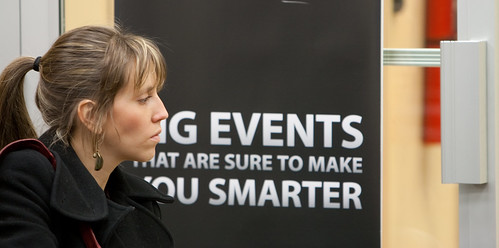B&H Evenspace Presentation: Travel Photography
By EricMesa
- 8 minutes read - 1662 words[caption id="" align=“aligncenter” width=“500” caption=“B&H Event Space - Where B&H holds classes on various topics”]  [/caption]
[/caption]
[caption id="" align=“alignleft” width=“240” caption=“Rudy Winston of Canon”] 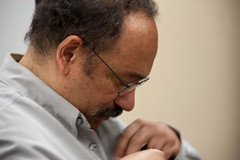 [/caption]
[/caption]
So the first B&H Event Space lecture I ever went to was earlier this April in a class about Travel Photography taught by Rudy Winston, an employee of Canon. His lecture was about taking a vacation specifically to get certain photos. In other words this was not about improving your photography while on vacation with the rest of the family. However, I found that a lot of the tips worked equally well for either kind of trip. Another key part of his lecture was taking pictures with the intention of loading them into a slideshow program as a means of sharing it with others. Before beginning the lecture, Rudy showed his slideshow and here’s what I picked up from that.
- One subject that can make a compelling photo is a set of trolley tracks running along a street.
- Take photos to document the transportation you took - buses, taxis, subways, etc
- you may want to take pictures of tourists to show you weren’t the only one there
- take pictures of your tickets to get on trains or to go to certain events
[caption id="" align=“alignright” width=“240” caption=“Rudy begins the talk”] 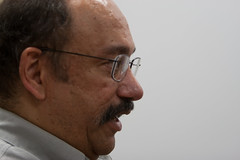 [/caption]
[/caption]
In the talk itself, Rudy mentioned that the most important thing is to start by thinking about what you like to photograph. In other words, do you like to photograph wildlife, nature, or buildings? This can make a huge difference in where you decide to go. For example, Prague, where Rudy went, has a lot of statues and buildings to photograph. If you hate architectural photographs, you might be bored there. Likewise, you wouldn’t want to waste the money going to the African Savannah if you hate wildlife photography. It’s also important to decide if this is going to only be a photographic trip or if you will partake in any tourist-y stuff. For Rudy, this was a purely photographic trip so if any location didn’t allow photography, he skipped it. You might find it hard to skip a certain museum just because they don’t allow photography, but then you are taking away time from being able to shoot. Finally, you need to know your goals. What do you want to see or capture?
[caption id="" align=“alignleft” width=“240” caption=“A selection of Canon’s Enthusiast and Pro Cameras, perfect for such a trip.”]  [/caption]
[/caption]
[caption id="" align=“alignright” width=“240” caption=“Some of Canon’s world-renowned L series lenses”] 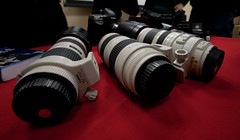 [/caption]
[/caption]
Next Rudy spoke about what equipment to take on such a trip. First of all, he said that almost anything is OK. Then he mentioned what he took. Camera-wise Rudy took the Canon 1D Mark III and the Canon 5D. The 1D is a camera with a sensor larger than the Canon Rebel (or XXXD) series, but smaller than full frame. Canon calls it APS-H and it’s a 1.3x crop factor on the lens. He got a bit ambitious and for lenses took the 100-400mm f4.5-5.6L IS, 16-35mm f2.8L II, 14mm f2.8L, 50mm f2.5 macro, and the 135mm f2.0. But this turned out to be impractical due to weight. He ended up putting the 100-400mm on the 1D and the 16-35mm on the 5D. The rest of the lenses stayed in the hotel for most of the trip. So the first lesson is to be mindful of how much your equipment will weigh and how practical it is to lug around. In order to maximize his ability to take photos and not waste time (and lose opportunities) changing lenses, he went around with both cameras so he could switch as appropriate. Rudy recommended the 70-300mm f4-5/6 IS as a good lens that doesn’t cost too much if you only have one camera and want a good range of focal lengths.
Continuing on the equipment front, Rudy moved on to talk about tripods. His advice was to only bring it if you need it for the shots you like to take. So if you are shooting lots of late night shots or macros bring it. If you are mostly shooting landscapes, bring it. Otherwise, like the extra lenses, it will probably end up spending a lot of time in the hotel room. He also mentioned that photographers tend to get hassled a lot more if they have a tripod. Rudy also recommended bringing a flash gun. Finally, check your equipment and make sure everything is in working order because you lug it overseas.
[caption id="" align=“alignleft” width=“240” caption=“Some of the fellow photographers learning from Rudy Winston”] 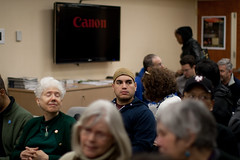 [/caption]
[/caption]
What about memory cards? Winston says it’s down to personal preference. You have to balance having everything on one card that can be lost or become corrupted vs having to constantly change cards. Also, you may want to bring a laptop or other such device to backup your memory cards or even to clear them. And if you are clearing your memory cards onto a laptop, do you bring an extra hard drive in case your laptop hard drive crashes. Ultimately the amount of risk you take is up to you. How much can you expect to shoot? Rudy shot 450 frames per day for a total of 35 GB!
[caption id="" align=“alignright” width=“240” caption=“A photo of my small camera bag with the Canon 10-22mm L”]  [/caption]
[/caption]
Rudy then went on to speak about shooting for a slide show. You may want to pick one subject and then photograph from different views, angles, and with different lenses. You can also show time by showing a sequence of photos shot only a second apart. Photographing the same subject at different times of day can also be quite effective when shown one after another. Pairs of images unrelated in time and space may also go well together in a slideshow. When editing your photos, loook for variety, not simply the very best photos. Also think of categories and themes and categories from the trip. You will arrange the photos into sections based on these categories. Rudy also mentioned with a slideshow, one may wish to record ambient sound to add in. This is something most photographers don’t think about. It can be done relatively cheaply with a field recorder. I only wrote down the name of the Windows software he recommended for making slideshows since I don’t have a Mac. Rudy recommended the Photodex Pro Show Gold. The program even allows you to make DVDs so you can share your slideshows away from your computer. In order to keep the images manageable for the slideshows software, you should resize your images to a height of 1080 (HD).
[caption id="" align=“alignleft” width=“240” caption=“I was inspired to take this photograph based on a postcard.”] 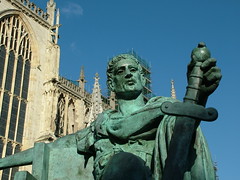 [/caption]
[/caption]
Rudy then moved into the subject of travel planning, again mentioning the importance of determining your personal goals. Learn about the area and decide what you want to photograph. Thing about which subjects and locations will be photogenic. Previsualizing your shots can be a very important and effective technique. This way you have an idea of the subject you want to capture and the end result. Otherwise you may find yourself just staring at the subject trying to decide what kinds of shots you want. This will waste your precious time. Rudy recommended the Lonely Planet books for background information and the DK Eyewitness travel books for photo inspirations and ideas. You should also use the internet to gain lots of information about the place you’re going to. Google Earth can help with logistics planning. He mentioned that many people often don’t realize how far things are so Google Earth can help you see if the subjects you want to photograph are on opposite ends of teh city. You can also see some geotagged images on Google Earth. It can also be helpful to check stock photo agencies to get some inspiration on the types of photos others take of your subjects. My photo of Constantine is one of my favorite photos from my trip to England and I took the photo on a challenge from my wife to match a postcard photo on sale in a nearby shop.
Some other travel tips Rudy mentioned included using the internet to find driving and train information as well as any problems with getting in and out of the area. Rudy recommended using public transportation as much as possible. Also consider time of day when planning your trip. As most photographers know/learn, the best light is in the morning and evening. So plan your indoors photography for the middle of the day. Also, try and wake up early as it may help you get some photos of some heavy tourist areas without all of the tourists. Study maps as much as possible. Consider only photographing two general areas per day. Allow time to simply walk the streets without your gear. Also, allow one day to decompress and just relax in the hotel. Finally, get into shape before you leave - may take a month or so.
Rudy then moved on to packing. With respect to clothing and jewelry be sensible. You don’t want to attract attention to yourself - especially since you’ll probably be preocupied trying to get a good shot. Don’t take more photographic gear than you can handle. Decide whether you will bring a laptop or not.
Finally, Rudy spoke about security. His first tip was to not obsess about it. Just look out and be aware. Work with the hotel staff and tip your housekeepers. If you treat them well, they will treat you well.
Rudy’s presentation was great. If you can get to New York, make sure you see it - I wasn’t able to capture everything he spoke about there. Also, he took questions during the lecture and I didn’t take notes on any of those. He routinely gives talks at B&H and I’ll definitely go to another one in the future.
